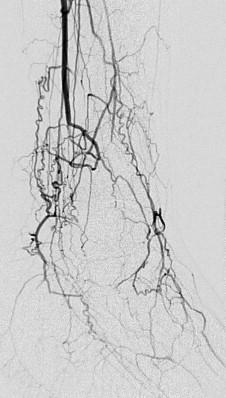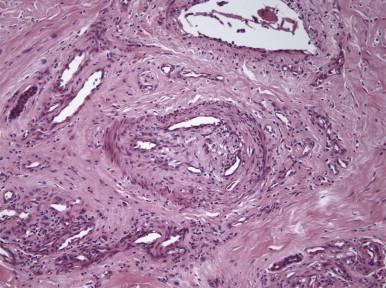Physical Address
304 North Cardinal St.
Dorchester Center, MA 02124
Thromboangiitis obliterans, or Buerger’s disease, is a relatively uncommon vascular disorder. It is considered a nonatherosclerotic, inflammatory occlusive disease that most commonly affects the intermediate and small arteries and veins of the extremities. Although there is a striking link with tobacco abuse, the specific etiologic mechanisms of Buerger’s disease remain unknown. Inflammatory, immunologic (including chronic periodontal infection), and prothrombotic factors as well as endothelial cell dysfunction have been associated with the disorder.
Buerger’s disease is reported more often in the Middle East and Asia, with a high incidence in patients in Japan, Korea, and India as well as Israeli Jews of Ashkenazi descent. In North America, the prevalence of the disease (13–20 cases/100,000) has decreased in the past 30 years, possibly caused by a decline in smoking. It is a potentially debilitating disease that requires frequent hospitalizations, and in almost 75% of patients it results in premature termination of their working life.
A clinical diagnosis of Buerger’s disease should be supported by vascular laboratory, radiographic, and at times pathologic findings. Cited criteria for clinical diagnosis include current or recent smoking history, symptom onset before age 45 years, infrapopliteal arterial occlusive lesions, upper limb involvement, phlebitis migrans, and absence of usual atherosclerotic risk factors other than smoking. It has been suggested that at least four of these five criteria must be met for diagnosis. Proximal source of emboli, arteritis, adventitial cystic disease, popliteal vascular entrapment, accelerated atherosclerosis (such as that related to diabetes mellitus or hyperhomocysteinemia), repetitive trauma, occupational injury, connective tissue disorders, and hypercoagulable states should all be considered in the differential diagnosis.
Thromboangiitis obliterans initially involves the distal arteries and veins in a segmental fashion, followed by more proximal arterial occlusive disease. The most common presentation is digital ischemia. On physical examination the fingers or toes are cold and tender. Pulses may be diminished or absent, and the Allen test may be positive. The skin may be pale or mottled, and more than half the patients have ischemic ulcerations at the time of presentation. Other findings can include recurrent superficial thrombophlebitis, paresthesias, Raynaud’s syndrome (>40%), and joint complaints. These can occur in the preocclusive phase of the disease. Blood assays in patients with suspected Buerger’s disease are useful to exclude alternative diagnoses.
Diagnostic vascular laboratory assessment includes segmental blood pressure measurements of all four limbs. This can identify patients with proximal occlusive disease who could benefit from intervention. Digital blood pressure measurements with plethysmography often demonstrate flattened waveforms. Echocardiography, computed tomography, and magnetic resonance imaging can be useful to exclude proximal sources of thromboemboli. Contrast arteriography remains the best diagnostic study, especially when the diagnosis is in doubt or arterial reconstruction is contemplated. In these patients, the arteries appear normal until they reach the distal extremity, where multiple tapered or abrupt occlusions are seen. A corkscrew appearance of numerous collaterals around these occlusions is a classic finding ( Figure 1 ).

Amputation specimens exhibit grossly edematous arteries and periarterial tissues with occlusive thrombus. The lesions are segmental, and adjacent nerves and veins are secondarily involved with fibrous encasement. Histologic examination reveals polymorphonuclear leukocyte arterial wall invasion and mural or occlusive luminal thrombus. This thrombus contains multinucleated giant cells and leukocytes, which in later stages is subject to recanalization ( Figure 2 ). Initially, these occlusive lesions lead to critical ischemia and tissue loss in the most distal parts of the extremity.

Microscopic inflammation mimicking Buerger’s disease may be observed in several inflammatory arteritides. Therefore, a diagnosis must be founded on clinical history supported by vascular laboratory and arteriographic findings. Intrathoracic and intraabdominal vascular involvement is rare; thus these patients have normal survival rates compared with other age-matched controls.
Patients and their families must be educated about the limb-threatening nature of the condition and the role of tobacco abstinence (including secondhand smoke), and such discussions should be clearly documented in the medical record. Asymptomatic limbs require good skin care, careful shoe selection, avoidance of mechanical injuries, and daily inspection for early tissue loss. Cold-sensitive patients should be instructed to avoid environmental stimuli.
Become a Clinical Tree membership for Full access and enjoy Unlimited articles
If you are a member. Log in here